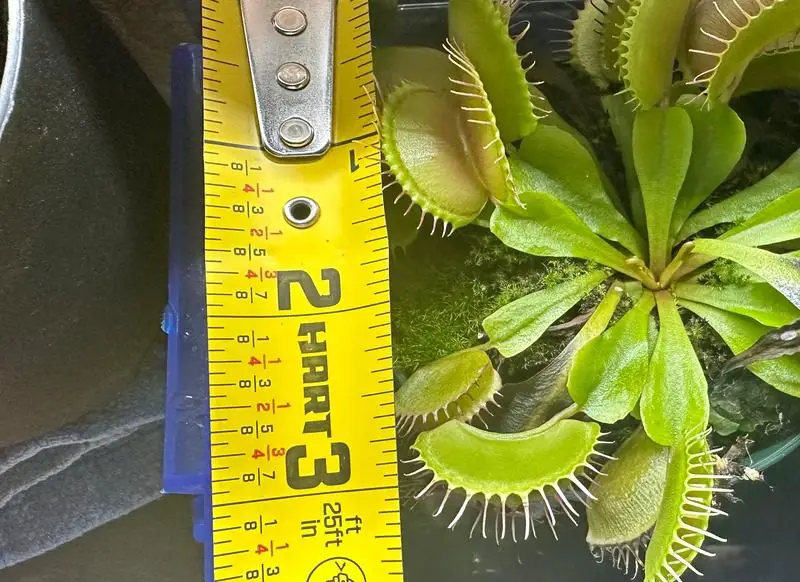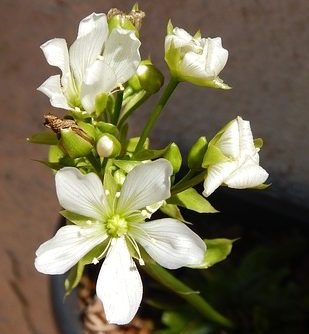Even though Venus fly traps are not extremely big plants, they can reach a formidable size to feature their interesting traps for catching bugs.
Adult Venus flytraps can reach a height of a foot, a trap size of one to two inches, and 5 inches in diameter. Some varieties grow vertically, others hug the ground and grow more horizontally, and some characterize by having larger dimensions, such as Dionaea B-52 and Ginormous
When you look at a Venus flytrap, you will notice the center. The center of the plant is where all the leaves originate. Through that center, you can expect a 5-inch diameter.
Vertically, Venus flytraps can be as tall as a foot (30 cm). And, the size of each trap (just the jaw like structure) would be about one inch (2.5 cm) long, which is enough to capture insects, such as a fly, small cricket, slug, or spiders.
Mature Venus Fly Trap Dimension Summary
- Horizontally: 5 inches (12.7 cm) in diameter
- Vertically: 1 foot (30 cm)
- Trap size: 1 inch (2.5 cm)
Interesting fact: Around year 4 to 6, the Venus fly trap reach its mature size. The plant will also reach overall maturity at the time and start producing flowers every year.
After reaching maturity, Venus fly traps can continue growing, but at a much slower pace.
Venus Fly Trap Size and Pot Requirements
Adult Venus fly traps can live happily in a 6 inch container (in diameter). You can always choose a larger pot and even a bog, but 6 inches is the recommended minimum to ensure the plant has enough space.
Besides the diameter, the vertical dimension of the pot is also important. Venus fly traps grow long roots that grow vertically in the grown. In order to promote growth, it is recommended you select a deep of of at least 4-5 inches in depth.
| Venus Flytrap Age | Trap Size | Pot Size (diameter) |
| 0-1 years (seedlings) | Tiny | Any size |
| 1-2 years | 1/8 inch | 2” |
| 2-3 years | 1/4 inch | 3″ |
| 3 years | 1/2 inch | 4″-5″ |
| 4+ years | 1 – 2 inches | 6″ |
As an example, these pots are great for Venus flytraps and can be purchased in amazon.com: https://amzn.to/3IYVGKU .
.

What is the largest Venus flytrap?
After some online research, I was not able to find Venus flytrap size records. The lack of recording might be due to the fact that Venus flytraps are not large plants (Unfortunately, for all those science-fiction fanatics, there are no human-size Venus flytraps). However, some cultivators have bred Venus flytraps varieties that surpass the standard Venus flytrap size.
The Dionaea B-52 and Dionaea Ginormous are Venus flytrap cultivars with traps that can reach the size of two inches, which is double the size of standard Venus flytraps. These varieties are considered to be among the biggest varieties of Venus fly traps out there!
The Dionaea B-52 is “A formidable clone produced by Henning Von Schmeling of the United States. The cultivator doesn’t signify the giant jet bomber but happened to be the code for plants he was needing. Vigorous and impressive, these large specimens also clump, producing a mass of large, yawning traps.”(D’Amato, 2013).
This variety of Venus fly traps are sold commercially in-stores and even online!
How to grow a large Venus flytrap?
The best strategy to grow Venus flytraps to their full size is to follow the care instructions. Venus flytraps are native to South Carolina and North Carolina in the United States. They are unique plants and require particular care to thrive. Here is a summary list of care instructions to grow large Venus flytraps.
Water: Venus flytraps need a lot of water. Your soil needs to be moist at all times. Also, you can’t water your plant with tap water (it has too many minerals and salts). Instead, use rainwater or distilled water.
Light: Venus flytraps require a lot of light. They must be placed in a strategic spot, where they can receive 12 hours of sun a day. However, Venus flytraps can live in partial shade if they receive 4-5 hours of direct sunlight.
Feeding: Venus flytraps can survive several months without being fed. However, they won’t thrive. For best results, feed your Venus flytrap once every two weeks or once every month. For more information, you can read our complete guide on how to feed a Venus flytrap :
:
How to Feed a Venus Flytrap?- Live and Dead Prey Options
Soil: Venus flytraps require nutrient-free soil with good drainage. Long-fibered sphagnum moss and sphagnum peat moss are both suitable options.
Fertilizer: There is no need to fertilize the plant. You can actually kill your plant with fertilizers.
It is easy to make mistakes when you are a novice grower, especially with Venus flytraps. But, remember that being a successful carnivorous plant grower requires patience, practice, and attention to detail. Learn about the species you are growing, build a proper setup, and be attentive to your plant’s needs. Then, you will cultivate large and healthy Venus flytraps.
Venus Flytrap Size vs. Growing Cycle
Venus flytraps undergo several stages every year. Generally, they will reach their largest size during spring or summer. And they will shrink during winter due to dormancy.
During late fall and winter, Venus flytraps will go dormant. Their dormancy period is similar to animal hibernation. When temperatures start to drop, Venus flytraps go dormant. During dormancy, their leaves wither, and the plant reduces in size. Since the physical changes due to dormancy are pronounced, the best time to photograph and measure your plant is during the warmer months. Finally, in the spring, Venus flytraps return to their original state and continue to grow and develop.
 After dormancy, Venus flytraps start flourishing. Then, during spring, Venus flytraps grow thick cylindrical structures. Those tubular structures will turn into flowers.
After dormancy, Venus flytraps start flourishing. Then, during spring, Venus flytraps grow thick cylindrical structures. Those tubular structures will turn into flowers.
Venus flytraps spend large amounts of energy producing flowers. After flowering, the plant will be weak for several months, and its growth will stagnate. If you want to make sure your Venus flytrap continuous to grow through the season, I would highly suggest cutting the flower stalks and preventing your plant from flowering. When spring starts, keep close attention to your plants. As soon as you notice a cylindrical trunk growing, cut it off. You might have to repeat this drill a few times since Venus flytraps attempt to grow several flowers during the season
Related Questions
What is the largest prey a Venus flytrap can eat?
Many people have the misconception that Venus flytraps can eat prey a lot larger than its trap. Even though Venus flytraps might be able to trap a reasonably large bug, they won’t always consume it. The rule of thumb is that Venus flytraps will only eat prey that is 1/3 of the size of the trap. Anything larger than that will be too difficult to digest. If the trap can’t close entirely after trapping a meal, the plant won’t process it. In those cases, the insect might still die because it is stuck. But even then, the plant won’t be able to digest it. When a trap can’t consume prey, it will witter, turn black and die.
Can a Venus flytrap harm a human?
Venus flytraps are safe for humans. Their traps might seem chilling when looked at closely, but they are surely not strong or big enough to hurt you. If you stick your finger inside a trap, you will feel it closing, but very mildly.
Generally, if you encounter Venus flytraps, avoid triggering the traps with your fingers. Venus flytraps employ significant amounts of energy to control those traps. The extra effort won’t kill them, but it will weaken the plant. Instead, observe the trapping mechanism by feeding the plant. It is amusing to watch Venus flytraps in action! If you are interested in feeding a Venus flytrap, we have written a guide on how to feed a Venus flytrap.  The article suggests prey options and the best methods to keep the plant healthy.
The article suggests prey options and the best methods to keep the plant healthy.
Sources:
Recommended Products for Growing Carnivorous Plants
Finding the best pots, lights, and soil for carnivorous plants is difficult. I have grown carnivorous plants for over 5 years, and these are the products I use. The links will take you to Amazon to view the prices and full specs:
- Carnivorous Plant Soil
- Carnivorous plant soil: https://amzn.to/422yLZa

- Carnivorous plant soil: https://amzn.to/422yLZa
- Artificial Lighting
- Small plant light for 1-2 plants: https://amzn.to/3oQsmSj

- T8 LED light fixture for multiple plants (6500k Cool White): https://amzn.to/3uWoeh2

- Small plant light for 1-2 plants: https://amzn.to/3oQsmSj
- Pots and Miscellaneus
- Nursery pots for single plants: https://amzn.to/3oL8YGq

- Nursery pots for single plants: https://amzn.to/3oL8YGq
- TDS meter to measure water quality: https://amzn.to/3g8VKLI

- Dried crickets to feed carnivorous plants: https://amzn.to/34QEnKv

